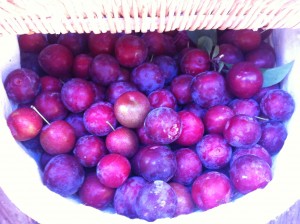It’s plum harvest time here in Southern California, a little earlier this year due to the recent heat. Today I’m looking forward to putting up a juicy batch of plums. As OrganicFoodee readers know, I’m not a fan of refined sugar at all, and yet, I do insist on using traditional recipes that contain sugar when I make jam. This is why…
Sugar is a vital ingredient in jams. It’s the combination of sugar, fruit pectin and the natural acid of fruit juice that makes jams gel. And it’s the sugar in jam that stops bacteria growing, keeping it safe to eat for a very long time, and being the original reason that jam was invented – to make summer and autumn fruit last all year round before the invention of the freezer.
Lower-sugar jams can be made using an alternative thickener or gel substitute. These include vegetable gum products, gelatine, liquid pectin, or agar flakes. However, the consistency of the jam will be very soft and runny, and the texture isn’t satisfying. Using a lower-sugar recipe mean the sugar can be reduced by up to 1/3, so although lower-sugar jams are lower in sugar, they are by no means sugar-free, and should still be eaten in moderation.
Not only are lower-sugar jams inferior in consistency, they also do not keep for long and must be refrigerated. It’s the sugar in jams that allows the fruit to keep away bacteria and microorganisms that would otherwise spoil them. Also, gelatin is not stable in the freezer, so lower-sugar jams should always be refrigerated and eaten within 4 weeks, but never frozen.
The best methods for preserving fruit without added sugar avoid the whole jam area. There are many traditional zero-added-sugar recipes. These include dried fruit, fruit leathers, and simply pureeing and freezing fruit.
Drying fruit is easy to do outside if you’re in relatively dry and sunny climate zone, like Southern California. If not, don’t despair, just get a dehydrator.
Fruit leathers are wonderfully versatile and healthy, and can be made with the addition of spices, ground nuts and seeds. They’re made using a dehydrators like my Excalibur. Simply puree the fruit and spread the paste with a spatula onto non-porous silicon sheets, then dry overnight.
When freezing fruit purees, first wash the fruit, and freeze it in small batches with as little air as possible in the containers. Vacuum sealed packages are best, as it’s the air that contains the microorganisms that will eventually make the fruit spoil, but even pureed fruit frozen in regular containers will last for up to a year in the freezer. Also, be aware that it will discolor unless a little lemon juice is added, but the discoloring will not effect the flavor.
Please let us know what you think by leaving a comment...
Like this page? Please link to us and let the world know!




